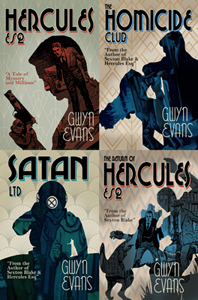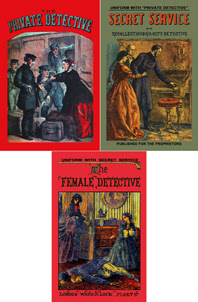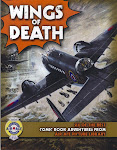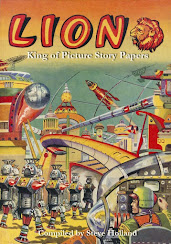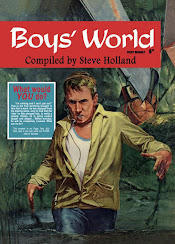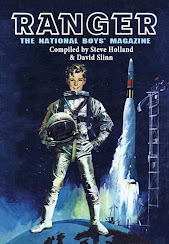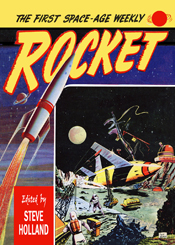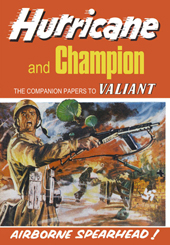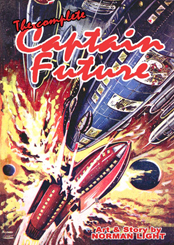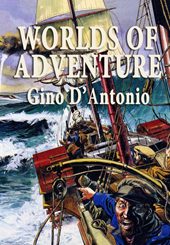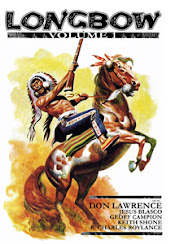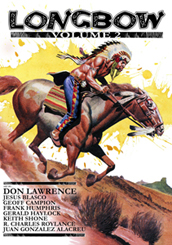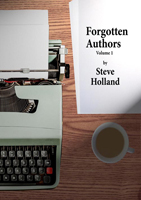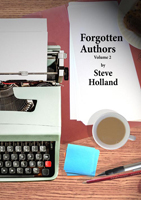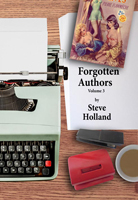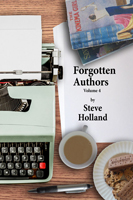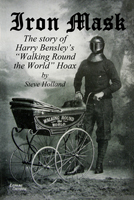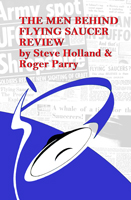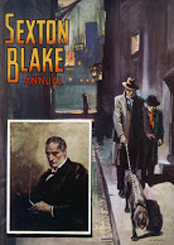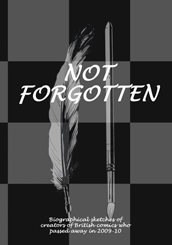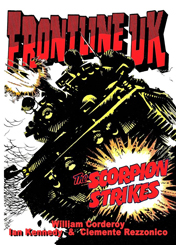Friday, November 28, 2014
Comic Cuts - 28 November 2014
Phew! The end of a pretty chaotic week and I'm looking forward to a weekend with my feet up.
I'm waiting on proof copies of Frontline UK, the new book from Bear Alley Books. The paperwork is all going through with D. C. Thomson, the copyright holders, and the book should be out on 8 December. I'm even happier with this one than the last one we did, although I'm still going to give myself a slap on the wrist for overdoing the introductory material again. I'd promised myself that I would only do a couple of pages, but, once I started writing, it turned into a jigsaw of background material and biographical sketches. Also, being a visual medium, it's nice to have the artwork reprinted at least roughly same size as it was intended.
The book runs to a nice 128 pages and will be cheaper than Arena to the tune of a whole pound. That's 20 shillings to us old folk!
While I'm waiting on the proofs to turn up, I've been trying to sort out my act as far as harnessing the tools available on the internet to sell some books. Amazon should soon list every book Bear Alley has published—most are already up but a couple are still being processed by Nielsen, who coordinate all the ISBN data.
I also have half the books now listed on eBay—only half because you're only allowed to list 10 for free per month via their "Buy It Now" service. I shall run it for a month or two and see if it's worth paying to have a few more listed. I chose the indexes (Lion, Ranger, Boys' World, Countdown) plus the four Sexton Blake Annuals, and a couple of random titles for my ten.
The price is higher on these sites than at the Bear Alley Books website because of the amount that both Amazon and eBay charge. It's still cheaper to buy direct. What I'm hoping is that people will see the books listed and, finger's crossed, do a search for Bear Alley and order from the website.
In between, I've been trying to crash through some e-mails, including one where I realised I'd made a slight goof. I was contacted by someone writing an article about J. Redding Ware who mentioned a possible blue plaque being put up at a house he lived in. Unfortunately I got the address wrong when I wrote about Ware back in 2008 and further information that has come to light in the past six years means I'm even less certain that Ware died in Peckham as I had originally stated.
Biographical research is like getting yourself a new kitten or puppy: however carefully you tread, you have to be prepared for the occasional slip-up.
Anyway, back to Amazon. There's a very simple way you can all help me finance Bear Alley Books: if you're going to visit Amazon to search for something, come to Bear Alley and use the Amazon search button over to the left of this column. You don't even have to search in the search box—just click on the search box and it will take you through to Amazon's home page. It won't cost you a penny, but I'll get a penny or two for sending you Amazon's way. Hopefully it will make up for the pathetic PLR payment I've just received from Irish public lending rights for 2013—a measly €2.14. About £1.70. Mostly from those Prion reprints I edited, for which I only get a percentage of the PLR. And as they get damaged and disappear from the shelves, so too does the PLR.
I can't believe how happy I was the first time I received a PLR payment! I earned 60p back in 2006/07... unfortunately, you had to earn at least £1 to be paid. I managed a real payment the following year: £5.92! I eventually hit the dizzy heights of £80 in 2011, but it has been downhill since then. I think I got £20 last year.
We've reached that time of year when the weather is often against me when it comes to my morning and afternoon walks. Long-time readers will know that I've been trying to get my weight down. I'm pleased to say that I'm losing roughly a pound a month; I put on a few pounds between January and March, so overall I've only lost 9 pounds this week.
So I was trying to think of a good way to illustrate how much 9 lbs is in practical terms and I think I've found the ideal way: its the weight of every Iain M. Banks novel from Consider Phlebas to Surface Detail, excluding his last novel. So the equivalent of 12 Iain M. Banks books. When you stack them up and weigh them in your hand, that's how much weight I've lost.
And that's just this year, because overall I've lost the equivalent of two sets of those same 12 novels, plus a third copy of his first five SF novels, Consider Phlebas, Player of Games, State of the Art, Use of Weapons and Against a Dark Background, a total of 21 lbs. (For the non-imperial amongst you, it also means I passed another milestone: I'm below 100kg for the first time in some years).
I still need to lose a lot of weight, so I'm not giving up on the exercise, but I'm quietly pleased that my weight is still going down, despite the fact that the weather is getting worse and I've ridden my exercise bike into the ground.
Technology news: we've got a Blu-ray player! And it works, although it almost didn't because at no point in the sales pitch for the player was there any mention that it didn't come with an HDMI cable. Maybe I should have realised but I'm quite naive about these things. Thankfully, Mel's Dad was coming over the morning we set it up and nipped into Curry's for us when he drove over.
It hasn't changed our lives beyond all recognition, but at least now, thanks to the wireless connection, we can get the iPlayer beamed to our TV. We have the same problem with some of the Freeview channels—Dave had now disappeared entirely along with all the other UK TV stations; but they were always terrible. We just don't get the strength of signal out here on the Essex coast. (Definitely a candidate for any "First World Problems" collection!)
Random scans. I picked up a copy of The Martian by Andrew Weir—I hear it's really good—and it reminded me of a book I read years ago. Shipwreck was also about an astronaut trapped on a hostile planet trying to survive using the limited resources around him. I thought it was brilliant—better, in my 12-year-old opinion, than the book it shared a prize with. The Gollancz/Sunday Times competition took place in 1975, I think, just as I was getting into SF in a big way. I was at the Grammar School by then, so I would have picked up the hardbacks either at Chelmsford Library or our smaller local library in 1976 or '77.
The anthology was originally entitled The Gollancz-Sunday Times Best SF Stories but was given the snappier title Let's Go To Golgotha—after Gary Kilworth's winning story—when it was published in paperback by Panther in 1979. The paperback mirrored Gollancz's famous yellow dust-jackets.
Shipwreck appeared in paperback in 1977 with a cover by Dave Bergen, the original of which I found on a dig around the internet... also a nice version of The Deep Range by Arthur C. Clarke artwork from a Pan Books edition also dating from some time in the 1970s.
Next week may be a bit patchy as I need to get down to figuring out what I'm doing next. I will have the upcoming releases column and mention of a couple of magazines just out, but that's all I'm guaranteeing.
Thursday, November 27, 2014
Captain C. H. Dent
Born in Croydon on 7 July 1889, Cecil Hudleston Dent was the second son of Herbert Wilkinson Dent and his wife Mabel Maxwell (née Boisragon). He was a boarder at Hill House School, Filsham Road, St. Leonard, Sussex.
He served in the East Africa Mounted Rifles attached to the Indian Army Reserve in 1914-15, coming to England in 1916 and subsequently became a Captain in the Indian Army.
Captain C. H. Dent was a prolific writer for the Amalgamated Press and D. C. Thomson, writing for the Champion and Triumph group under various pen-names (Cecil Fanshaw, John Hudleston, Robert Hudleston, and house names Mark Grimshaw and Hal Wilton) in the 1920s and 1930s and anonymously to The Wizard and other Thomson papers.
After the war he found some success under his own name (Captain C. H. Dent) writing novels about horse racing which are nowadays very collectable thanks to their illustrations by Lionel Edwards.
He died in Hove, Sussex, in 1951, aged 62.
PUBLICATIONS
Novels as Captain C. H. Dent
Long Odds. Dublin, Mellifont Press, 1933.
False Colours. London, Eldon Press, 1937.
The Sweepstake Colt. London, John Hamilton, 1940.
Fate's Handicap. Dublin, Mellifont Press, 1944.
The Copper Horse. The story of a steeplechasing horse from his point of view, illus. Lionel Edwards. London, Hutchinson & Co., 1948.
Head High, Hands Low: A story of horses, ponies and riders, illus. Lionel Edwards. London, Hutchinson & Co., 1949.
Second Fiddle, Son of Viola, illus. Lionel Edwards. London, Hutchinson & Co., 1951.
Novels as Cecil Fanshaw
The Rebel Jockey. London, Amalgamated Press (Champion Lib. 5), Apr 1929.
Trooper Ted of the S.A. Police. London, Amalgamated Press (Champion Lib. 10), Jun 1929.
Stunters of the Airway. London, Amalgamated Press (Champion Lib. 22), Dec 1929.
Mountie Mike of the Yukon Trail. London, Amalgamated Press (Champion Lib. 27), Mar 1930.
With the Legion of Adventure! London, Amalgamated Press (Champion Lib. 36), Jul 1930.
Pirate Plunder. London, Amalgamated Press (Champion Lib. 40), Sep 1930.
Fighters of the Foreign Legion. London, Amalgamated Press (Champion Lib. 45), Dec 1930.
Galloper Dan o' the Mounted. London, Amalgamated Press (Champion Lib. 52), Mar 1931.
The Toughest Ranger in the Rockies! London, Amalgamated Press (Champion Lib. 60), Jul 1931.
Highwayman Ned. London, Amalgamated Press (Champion Lib. 69), Dec 1931.
Crashing Through the Jungle Line! London, Amalgamated Press (Champion Lib. 74), Feb 1932.
Forward the Legion! London, Amalgamated Press (Champion Lib. 81), Jun 1932.
The 1930 Robinson Crusoes! London, Amalgamated Press (Champion Lib. 86), Aug 1932.
Sea-Wolves! London, Amalgamated Press (Champion Lib. 91), Nov 1932.
The Fighting Shadow; or, Detective Jim’s Biggest Case. London, Amalgamated Press (Champion Lib. 96), Jan 1933.Hammerfist (Hammersfist). London, Amalgamated Press (Champion Lib. 101), Apr 1933.
Barred from Mystery Ranch. London, Amalgamated Press (Champion Lib. 108), Jul 1933.King of the Gladiators. London, Amalgamated Press (Champion Lib. 116), Nov 1933.
Hammerfist on the Trail of Yukon Gold (Hammerfist). London, Amalgamated Press (Champion Lib. 120), Jan 1934.
Captain Moonlight: the Iron-Fisted Highwayman. London, Amalgamated Press (Champion Lib. 130), Jun 1934.
Boss of the Outlawed Legion. London, Amalgamated Press (Champion Lib. 134), Aug 1934.
The Dandy Pirate. London, Amalgamated Press (Champion Lib. 142), Dec 1934.
Black Cheetah. London, Amalgamated Press (Champion Lib. 148), Mar 1935.
The Hiking Jockey. London, Amalgamated Press (Champion Lib. 154), Jun 1935.
The Racing Highwayman. London, Amalgamated Press (Champion Lib. 172), Mar 1936.
The Curse Of Ka! London, Amalgamated Press (Champion Lib. 174), Apr 1936.
Bare-Fist Benson—The Battling Gypsy. London, Amalgamated Press (Champion Lib. 183), Sep 1936.
Kazan—The Racing Cossack. London, Amalgamated Press (Champion Lib. 189), Dec 1936.
The Sporting Pirate. London, Amalgamated Press (Champion Lib. 201), Jun 1937.
Boss of the Timber Toughs. London, Amalgamated Press (Champion Lib. 211), Nov 1937.
The $1,000,000 Legionnaires (Husky King). London, Amalgamated Press (Champion Lib. 221), Apr 1938.
Husky & Co.—The Toughest Trio on the Turf (Husky King). London, Amalgamated Press (Champion Lib. 223), May 1938.
The Robinson Crusoe Heavyweight. London, Amalgamated Press (Champion Lib. 229), Aug 1938.
“President” Husky (Husky King). London, Amalgamated Press (Champion Lib. 236), Nov 1938.
Novels as Robert Hudleston
The Ivory Trail. London, Amalgamated Press (BFL2/361), Dec 1932.
Non-fiction as Captain C. H. Dent
The Horse Has Four Legs. Some reminiscences and suggestions. London, Hutchinson & Co., 1944.
He served in the East Africa Mounted Rifles attached to the Indian Army Reserve in 1914-15, coming to England in 1916 and subsequently became a Captain in the Indian Army.
Captain C. H. Dent was a prolific writer for the Amalgamated Press and D. C. Thomson, writing for the Champion and Triumph group under various pen-names (Cecil Fanshaw, John Hudleston, Robert Hudleston, and house names Mark Grimshaw and Hal Wilton) in the 1920s and 1930s and anonymously to The Wizard and other Thomson papers.
After the war he found some success under his own name (Captain C. H. Dent) writing novels about horse racing which are nowadays very collectable thanks to their illustrations by Lionel Edwards.
He died in Hove, Sussex, in 1951, aged 62.
PUBLICATIONS
Novels as Captain C. H. Dent
Long Odds. Dublin, Mellifont Press, 1933.
False Colours. London, Eldon Press, 1937.
The Sweepstake Colt. London, John Hamilton, 1940.
Fate's Handicap. Dublin, Mellifont Press, 1944.
The Copper Horse. The story of a steeplechasing horse from his point of view, illus. Lionel Edwards. London, Hutchinson & Co., 1948.
Head High, Hands Low: A story of horses, ponies and riders, illus. Lionel Edwards. London, Hutchinson & Co., 1949.
Second Fiddle, Son of Viola, illus. Lionel Edwards. London, Hutchinson & Co., 1951.
Novels as Cecil Fanshaw
The Rebel Jockey. London, Amalgamated Press (Champion Lib. 5), Apr 1929.
Trooper Ted of the S.A. Police. London, Amalgamated Press (Champion Lib. 10), Jun 1929.
Stunters of the Airway. London, Amalgamated Press (Champion Lib. 22), Dec 1929.
Mountie Mike of the Yukon Trail. London, Amalgamated Press (Champion Lib. 27), Mar 1930.
With the Legion of Adventure! London, Amalgamated Press (Champion Lib. 36), Jul 1930.
Pirate Plunder. London, Amalgamated Press (Champion Lib. 40), Sep 1930.
Fighters of the Foreign Legion. London, Amalgamated Press (Champion Lib. 45), Dec 1930.
Galloper Dan o' the Mounted. London, Amalgamated Press (Champion Lib. 52), Mar 1931.
The Toughest Ranger in the Rockies! London, Amalgamated Press (Champion Lib. 60), Jul 1931.
Highwayman Ned. London, Amalgamated Press (Champion Lib. 69), Dec 1931.
Crashing Through the Jungle Line! London, Amalgamated Press (Champion Lib. 74), Feb 1932.
Forward the Legion! London, Amalgamated Press (Champion Lib. 81), Jun 1932.
The 1930 Robinson Crusoes! London, Amalgamated Press (Champion Lib. 86), Aug 1932.
Sea-Wolves! London, Amalgamated Press (Champion Lib. 91), Nov 1932.
The Fighting Shadow; or, Detective Jim’s Biggest Case. London, Amalgamated Press (Champion Lib. 96), Jan 1933.Hammerfist (Hammersfist). London, Amalgamated Press (Champion Lib. 101), Apr 1933.
Barred from Mystery Ranch. London, Amalgamated Press (Champion Lib. 108), Jul 1933.King of the Gladiators. London, Amalgamated Press (Champion Lib. 116), Nov 1933.
Hammerfist on the Trail of Yukon Gold (Hammerfist). London, Amalgamated Press (Champion Lib. 120), Jan 1934.
Captain Moonlight: the Iron-Fisted Highwayman. London, Amalgamated Press (Champion Lib. 130), Jun 1934.
Boss of the Outlawed Legion. London, Amalgamated Press (Champion Lib. 134), Aug 1934.
The Dandy Pirate. London, Amalgamated Press (Champion Lib. 142), Dec 1934.
Black Cheetah. London, Amalgamated Press (Champion Lib. 148), Mar 1935.
The Hiking Jockey. London, Amalgamated Press (Champion Lib. 154), Jun 1935.
The Racing Highwayman. London, Amalgamated Press (Champion Lib. 172), Mar 1936.
The Curse Of Ka! London, Amalgamated Press (Champion Lib. 174), Apr 1936.
Bare-Fist Benson—The Battling Gypsy. London, Amalgamated Press (Champion Lib. 183), Sep 1936.
Kazan—The Racing Cossack. London, Amalgamated Press (Champion Lib. 189), Dec 1936.
The Sporting Pirate. London, Amalgamated Press (Champion Lib. 201), Jun 1937.
Boss of the Timber Toughs. London, Amalgamated Press (Champion Lib. 211), Nov 1937.
The $1,000,000 Legionnaires (Husky King). London, Amalgamated Press (Champion Lib. 221), Apr 1938.
Husky & Co.—The Toughest Trio on the Turf (Husky King). London, Amalgamated Press (Champion Lib. 223), May 1938.
The Robinson Crusoe Heavyweight. London, Amalgamated Press (Champion Lib. 229), Aug 1938.
“President” Husky (Husky King). London, Amalgamated Press (Champion Lib. 236), Nov 1938.
Novels as Robert Hudleston
The Ivory Trail. London, Amalgamated Press (BFL2/361), Dec 1932.
Non-fiction as Captain C. H. Dent
The Horse Has Four Legs. Some reminiscences and suggestions. London, Hutchinson & Co., 1944.
Labels:
Author
Wednesday, November 26, 2014
Leslie Bell
Born in Horden, County Durham, on 16 September 1915, Leslie Bell was educated at Horden Elementary School. He married Daphne Taylor (1920-1970) in 1940 with whom he had a daughter, Barbara (1944- ), who married boxer Brian Nancurvis (who fought as Brian Curvis). He later married Emma Daniels in 1975.
Bell was best known for his writings about boxing. In the years after the Second World War, he wrote a number of books for the cheap paperback market, including a guide to stopping smoking and a book on improving your boxing. He wrote studies of Freddie Mills, Bruce Woodcock and others, also penning a novel about boxing entitled Fight Racket.
Later factual books included Sabotage, a biography of J. Elder Wills, the film director who became head of Sabotage and Camouflage during the Second World War, Destined Meeting, about Dr Philip Bloom and his wife, who were held captive by the Japanese following the siege of Singapore, and Bella of Blackfriars, the biography of actress and boxing promoter Bella Burge. He later wrote the screenplay Nudist Paradise with Denise Kaye (1959). He reputedly also wrote many novelettes under various pen-names as well as contributing anonymously to The Wizard boys' paper.
Bell, a member of the Institute of Journalists, lived at 33 Woodhill Crescent, Kenton, nr Harrow, Middlesex, before retiring to the Gower Peninsula in south Wales in around 1963. He died there on 12 April 1995.
PUBLICATIONS
Novels (series: Bat Brady)
The Fight Racket. London, Background [Sports-Crime Novel], Oct 1949.
Jim Strange. London, Herbert Jenkins, 1952.
The Laughing Fish (Brady). Meridian Books, Sep 1952.
Ring the Bell, Sister! (Brady). London, T. Werner Laurie, Jul 1956.
Non-fiction
You Will Not Smoke: How to Stop Smoking. London, Postlib Publications, Jul 1946.
Boxing Spotlight, 1949. London, Findon, May 1949.
Improve Your Boxing (by Nat Seller, collated and edited by Leslie Bell). London, Findon, 1949.
Focus on Freddie Mills. London, Background Books, Jun 1949.
Focus on Bruce Woodcock. London, Background Books, Aug 1949.
Men Behind the Gloves. C & J Temple, Jul 1950.
Inside the Fight Game. London, Rockliff, Jun 1952.
Sabotage!: The story of Lt. Col J. Elder Wills. London, T. Werner Laurie, Oct 1957.
Destined Meeting. London, Odhams Press, 1959.
Bella of Blackfriars. London, Odhams Press, 1960.
OTHERS
Screenplays: Nudist Paradise, with Denise Kaye (1959).
Bell was best known for his writings about boxing. In the years after the Second World War, he wrote a number of books for the cheap paperback market, including a guide to stopping smoking and a book on improving your boxing. He wrote studies of Freddie Mills, Bruce Woodcock and others, also penning a novel about boxing entitled Fight Racket.
Later factual books included Sabotage, a biography of J. Elder Wills, the film director who became head of Sabotage and Camouflage during the Second World War, Destined Meeting, about Dr Philip Bloom and his wife, who were held captive by the Japanese following the siege of Singapore, and Bella of Blackfriars, the biography of actress and boxing promoter Bella Burge. He later wrote the screenplay Nudist Paradise with Denise Kaye (1959). He reputedly also wrote many novelettes under various pen-names as well as contributing anonymously to The Wizard boys' paper.
Bell, a member of the Institute of Journalists, lived at 33 Woodhill Crescent, Kenton, nr Harrow, Middlesex, before retiring to the Gower Peninsula in south Wales in around 1963. He died there on 12 April 1995.
PUBLICATIONS
Novels (series: Bat Brady)
The Fight Racket. London, Background [Sports-Crime Novel], Oct 1949.
Jim Strange. London, Herbert Jenkins, 1952.
The Laughing Fish (Brady). Meridian Books, Sep 1952.
Ring the Bell, Sister! (Brady). London, T. Werner Laurie, Jul 1956.
Non-fiction
You Will Not Smoke: How to Stop Smoking. London, Postlib Publications, Jul 1946.
Boxing Spotlight, 1949. London, Findon, May 1949.
Improve Your Boxing (by Nat Seller, collated and edited by Leslie Bell). London, Findon, 1949.
Focus on Freddie Mills. London, Background Books, Jun 1949.
Focus on Bruce Woodcock. London, Background Books, Aug 1949.
Men Behind the Gloves. C & J Temple, Jul 1950.
Inside the Fight Game. London, Rockliff, Jun 1952.
Sabotage!: The story of Lt. Col J. Elder Wills. London, T. Werner Laurie, Oct 1957.
Destined Meeting. London, Odhams Press, 1959.
Bella of Blackfriars. London, Odhams Press, 1960.
OTHERS
Screenplays: Nudist Paradise, with Denise Kaye (1959).
Labels:
Author
Tuesday, November 25, 2014
A. R. Linden
Linden was a prolific and regular author for D. C. Thomson's boys' papers, contributing anonymously to at least The Hotspur and The Wizard. He was one of the first authors of the famous Red Circle School stories, his first contribution appearing in issue 3 (15 September 1933), following on from the debut tales by R. G. Thomas.
Almost nothing is known about Linden or his work; the only confirmed later stories are two serials from The Wizard: "The Man's a Marvel" (1955), about a bodyguard named Jenkin, and—probably his last Thomson serial—"Chopper Barton" (1957), about a fairground boxer. The latter was reprinted in 1963 towards the end of The Wizard's run as a story paper.
Born in around 1906, Albert Ronald Linden lived at 24 North End Avenue, North End, Portsmouth, where he died on 30 June 1957, aged 50. He left effects of £1,700 to his widow, Kathleen Alice Eleanor Linden. Kathleen survived him by many years; born 24 February 1910, she died in 1999, aged 89.
Almost nothing is known about Linden or his work; the only confirmed later stories are two serials from The Wizard: "The Man's a Marvel" (1955), about a bodyguard named Jenkin, and—probably his last Thomson serial—"Chopper Barton" (1957), about a fairground boxer. The latter was reprinted in 1963 towards the end of The Wizard's run as a story paper.
Born in around 1906, Albert Ronald Linden lived at 24 North End Avenue, North End, Portsmouth, where he died on 30 June 1957, aged 50. He left effects of £1,700 to his widow, Kathleen Alice Eleanor Linden. Kathleen survived him by many years; born 24 February 1910, she died in 1999, aged 89.
Labels:
Author
Monday, November 24, 2014
Jeffrey M. Boatfield
Jeffrey Montagu Boatfield was born in Sudbury, Middlesex, on 25 March 1924, the son of Stanley Edgar Boatfield (1888-1959) and his wife Sophia Clara (nee Graham, 1881-1952). Stanley and Sophia were married in 1920 and had two sons, Jeffrey's elder sibling being Graham Stanley Boatfield (1921-2014).
Educated at Dover College and Wycliffe College, Jeffrey Boatfield obtained a diploma in horticulture from the University of Reading. He wrote extensively about horticulture, contributing to Smallholder, Grower, Commercial Grower, Countryman and the Kentish Express. He also wrote for boys under the pen-name Jeff Jeffries from around 1950, contributing to Boy's Own Paper and the Amalgamated Press; he is known to have anonymously contributed the brief 3-part series "Front Page Fergusson" to The Wizard in 1959 (#1755-1757, 3 Oct—17 Oct 1959).
Boatfield was married to Patricia Nina Igglesden in Folkestone, Kent, in 1957. They lived at Sheather Farm, Lenham Heath, near Maidstone, Kent, until at least 1968; they later moved to
Littleton, near Winchester, Hampshire where Jeffrey died in 2003, aged 79.
PUBLICATIONS
Novels as Jeff Jeffries
Davy Crockett, Frontiersman, illus. R. S. Embleton. London & Glasgow, Collins, 1956; as Remember the Alamo!, London & Glasgow, Childrens' Press, 1962.
The Fighting Marshal: The Story of Wyatt Earp. London & Glasgow, Collins, 1958; as The Story of Wyatt Earp, London, Collins Clear-Type Press, 1960.
Seventh Cavalry. London & Glasgow, Collins, 1959.
Beyond the Shining Mountains, illus. P. J. Gillespie. London, Hutchinson, 1960.
Bushwhacked. New York, Belmont Tower, Dec 1967.
Non-fiction as Jeffrey M. Boatfield
Soft Fruit. Modern methods of commercial growing and marketing for processing. London, Pearson, 1961.
Educated at Dover College and Wycliffe College, Jeffrey Boatfield obtained a diploma in horticulture from the University of Reading. He wrote extensively about horticulture, contributing to Smallholder, Grower, Commercial Grower, Countryman and the Kentish Express. He also wrote for boys under the pen-name Jeff Jeffries from around 1950, contributing to Boy's Own Paper and the Amalgamated Press; he is known to have anonymously contributed the brief 3-part series "Front Page Fergusson" to The Wizard in 1959 (#1755-1757, 3 Oct—17 Oct 1959).
Boatfield was married to Patricia Nina Igglesden in Folkestone, Kent, in 1957. They lived at Sheather Farm, Lenham Heath, near Maidstone, Kent, until at least 1968; they later moved to
Littleton, near Winchester, Hampshire where Jeffrey died in 2003, aged 79.
PUBLICATIONS
Novels as Jeff Jeffries
Davy Crockett, Frontiersman, illus. R. S. Embleton. London & Glasgow, Collins, 1956; as Remember the Alamo!, London & Glasgow, Childrens' Press, 1962.
The Fighting Marshal: The Story of Wyatt Earp. London & Glasgow, Collins, 1958; as The Story of Wyatt Earp, London, Collins Clear-Type Press, 1960.
Seventh Cavalry. London & Glasgow, Collins, 1959.
Beyond the Shining Mountains, illus. P. J. Gillespie. London, Hutchinson, 1960.
Bushwhacked. New York, Belmont Tower, Dec 1967.
Non-fiction as Jeffrey M. Boatfield
Soft Fruit. Modern methods of commercial growing and marketing for processing. London, Pearson, 1961.
Labels:
Author
Sunday, November 23, 2014
Lee Child cover gallery
Killing Floor (Bantam, 1998)
Bantam 978-0553-50540-5, 1999
---- [30th imp.], 522pp, £7.99. Cover design by Henry Steadman
Die Trying (Bantam, 1999)
Bantam, 2000
Bantam 978-0553-50005-2, 2010, 557pp, £7.99. Cover design by Henry Steadman
Tripwire (Bantam, 1999)
Bantam 978-0553-81185-8, 2000.
---- [17th imp.], 540pp, £7.99. Cover design by Henry Steadman
The Visitor
Echo Burning (Bantam, 2001)
Bantam, 2002
Bantam 978-0553-50008-3, 2011, 572pp, £7.99. Cover design by Henry Steadman
Without Fail (Bantam, 2002)
Bantam 978-0553-81343-2, 2003.
---- [8th imp.] n.d., 555pp, £6.99. Cover design by Henry Steadman
Persuader (Bantam, 2003)
Bantam 0553-81344-7, 2004.
---- [4th imp.], n.d., 542pp, £6.99. Cover photo by National Geographic
The Enemy (Bantam, 2004)
Bantam 978-0553-81585-6, 2005.
---- [11th imp.], 558pp, £7.99. Cover design by Henry Steadman
One Shot (Bantam, 2005)
Bantam 978-0553-81586-3, 2006.
---- [4th imp.], 510pp, £6.99. Cover design by Henry Steadman
Bantam, 2011
as Jack Reacher: One Shot, Bantam 978-0857-50118-9, 2012, 494pp, £7.99. Cover: photo (MTI)
The Hard Way (Bantam, 2006)
Bantam 978-0553-81587-0, 2007, 522pp, £6.99. Cover design by Henry Steadman
Bad Luck and Trouble (Bantam, 2007)
Bantam 978-0553-81810-9, 2008, 527pp, £6.99. Cover design by Henry Steadman
Nothing to Lose (Bantam, 2008)
Bantam 978-0553-82441-4, 2009, 554pp, £7.99. Cover design by Stephen Mulcahey
Gone Tomorrow (Bantam, 2009)
Bantam 978-0553-82469-8, 2010, 556pp, £7.99. Cover design by Stephen Mulcahey
61 Hours (Bantam, 2010)
Bantam 978-0553-82556-5, 2010, 492pp, £7.99. Cover design by Stephen Mulcahey
Worth Dying For (Bantam, 2010)
Bantam 978-0553-82548-9, 2011, 533pp, £7.99. Cover design by Stephen Mulcahey
The Affair (Bantam, 2011)
Bantam 978-0533-82550-3, 2012, 541pp, £7.99. Cover design by Stephen Mulcahey
A Wanted Man (Bantam, 2012)
Bantam 978-0553-50540-5, 1999
---- [30th imp.], 522pp, £7.99. Cover design by Henry Steadman
Die Trying (Bantam, 1999)
Bantam, 2000
Bantam 978-0553-50005-2, 2010, 557pp, £7.99. Cover design by Henry Steadman
Tripwire (Bantam, 1999)
Bantam 978-0553-81185-8, 2000.
---- [17th imp.], 540pp, £7.99. Cover design by Henry Steadman
The Visitor
Echo Burning (Bantam, 2001)
Bantam, 2002
Bantam 978-0553-50008-3, 2011, 572pp, £7.99. Cover design by Henry Steadman
Without Fail (Bantam, 2002)
Bantam 978-0553-81343-2, 2003.
---- [8th imp.] n.d., 555pp, £6.99. Cover design by Henry Steadman
Persuader (Bantam, 2003)
Bantam 0553-81344-7, 2004.
---- [4th imp.], n.d., 542pp, £6.99. Cover photo by National Geographic
The Enemy (Bantam, 2004)
Bantam 978-0553-81585-6, 2005.
---- [11th imp.], 558pp, £7.99. Cover design by Henry Steadman
One Shot (Bantam, 2005)
Bantam 978-0553-81586-3, 2006.
---- [4th imp.], 510pp, £6.99. Cover design by Henry Steadman
Bantam, 2011
as Jack Reacher: One Shot, Bantam 978-0857-50118-9, 2012, 494pp, £7.99. Cover: photo (MTI)
The Hard Way (Bantam, 2006)
Bantam 978-0553-81587-0, 2007, 522pp, £6.99. Cover design by Henry Steadman
Bad Luck and Trouble (Bantam, 2007)
Bantam 978-0553-81810-9, 2008, 527pp, £6.99. Cover design by Henry Steadman
Nothing to Lose (Bantam, 2008)
Bantam 978-0553-82441-4, 2009, 554pp, £7.99. Cover design by Stephen Mulcahey
Gone Tomorrow (Bantam, 2009)
Bantam 978-0553-82469-8, 2010, 556pp, £7.99. Cover design by Stephen Mulcahey
61 Hours (Bantam, 2010)
Bantam 978-0553-82556-5, 2010, 492pp, £7.99. Cover design by Stephen Mulcahey
Worth Dying For (Bantam, 2010)
Bantam 978-0553-82548-9, 2011, 533pp, £7.99. Cover design by Stephen Mulcahey
The Affair (Bantam, 2011)
Bantam 978-0533-82550-3, 2012, 541pp, £7.99. Cover design by Stephen Mulcahey
A Wanted Man (Bantam, 2012)
Saturday, November 22, 2014
Bill Wellings
Back on 8 November 2006, I penned a few sentences about Bill Wellings. At that time I knew nothing about William ('Bill') Wellings other than the fact that he scripted the comic strips "Nicky Nobody" (1954-62) and "Ginger & Co." (1960) for the weekly Swift and, presumably, also wrote their adventures for the Swift Annual. He was also the scriptwriter on "Cavendish Brown, M.D." for Eagle (1958-59).
Oddly enough, Nicky Nobody appeared in Swift Annual 3, but Bill Wellings wasn't listed as an author... however, one F. L. Wellings was listed that year and I suspect F. L. is related and might even be Florence Lydia Wellings (1910-1996), the only 'F. L.' I can trace in genealogical records.
Some further digging makes me now wonder whether Bill was William Ernest Welling, born in Walsall, Staffordshire, on 16 July 1907, who died in Cheltenham, Gloucestershire, in 1999. There's also a chance that Florence Lydia was his sister rather than (as I assumed back in 2006) his wife. Florence Lydia, born on 2 November 1910, had died in Gloucester, Gloucestershire, three years before. A Florence L. Wellings is recorded as born in West Bromwich, Staffordshire, in 4Q 1910.
Other than his comic strips, Wellings is credited with a single novel based on the Nicky Nobody character. It is probable that he is also the Bill Wellings credited with writing the "J.J." strip for the Sunday Express in 1962, drawn by Roy Dewar. If that is the case, it seems likely that Wellings was a freelance journalist who wrote comic strips on the side rather than a full-time comic scriptwriter.

Novels
Nicky Nobody and the Rocket Spies. London, Hulton Press, 1958.
(* The artwork is from Swift Annual 1962 (1961), drawn by Daphne Rowles. Nicky Nobody is © IPC Media.)
Oddly enough, Nicky Nobody appeared in Swift Annual 3, but Bill Wellings wasn't listed as an author... however, one F. L. Wellings was listed that year and I suspect F. L. is related and might even be Florence Lydia Wellings (1910-1996), the only 'F. L.' I can trace in genealogical records.
Some further digging makes me now wonder whether Bill was William Ernest Welling, born in Walsall, Staffordshire, on 16 July 1907, who died in Cheltenham, Gloucestershire, in 1999. There's also a chance that Florence Lydia was his sister rather than (as I assumed back in 2006) his wife. Florence Lydia, born on 2 November 1910, had died in Gloucester, Gloucestershire, three years before. A Florence L. Wellings is recorded as born in West Bromwich, Staffordshire, in 4Q 1910.
Other than his comic strips, Wellings is credited with a single novel based on the Nicky Nobody character. It is probable that he is also the Bill Wellings credited with writing the "J.J." strip for the Sunday Express in 1962, drawn by Roy Dewar. If that is the case, it seems likely that Wellings was a freelance journalist who wrote comic strips on the side rather than a full-time comic scriptwriter.

Novels
Nicky Nobody and the Rocket Spies. London, Hulton Press, 1958.
(* The artwork is from Swift Annual 1962 (1961), drawn by Daphne Rowles. Nicky Nobody is © IPC Media.)
Labels:
Author
Friday, November 21, 2014
Comic Cuts - 21 November 2014
Let's begin with a few more details about the new book from Bear Alley Books. Frontline UK is an invasion story in which foreign forces attack and occupy Great Britain. Five months before Bill Savage started fighting back against the Volgs in 2000AD's "Invasion", the crew of a single Scorpion tank began their own war of resistance against the forces of the Yellow Crescent.
The book gathers together both series of the strip from the pages of Bullet, where it debuted in September 1976. The artwork was by the peerless Ian Kennedy, with later episodes by Argentinean artist Clemente Rezzonico, who made a fantastic job of continuing the strip and is today still cranking out fantastic artwork for Commando (his next book is due in December—cover immediately below).
I have been piecing together the introductory material over the past week. So far we have a general introduction, offering some insight into the history of the strip and its origins in the fond memories of a 1950s text story by a D. C. Thomson editor. We will also meet the people "behind the lines": author Bill Corderoy and artists Ian Kennedy and Clemente Rezzonico. There will hopefully also be a bonus strip, but I'll have more news of that next week. And, hopefully, by then we will also have an advance order page set up.
And then it'll be onto the next book... no rest for the wicked!
My ongoing battle with technology has become war of attrition that I'm losing—and losing heavily. Hopefully the Rule of Three applies here and I can now relax that the third thing has gone wrong. First it was an external hard drive that needed to be replaced, then the washing machine. Now it's our DVD player.
The damn thing has been acting up for months now. It would need to warm up for about ten minutes before you could get any use out of it. The drawer where you put the DVDs would jut out slightly when you tried to open it but never open fully. Every now and then it would open for no reason. Getting the menu to appear was a gamble; you had to try it at just the right time or the screen would go dark. Recording was a bit hit and miss.
Mel and I were thinking of getting a new player in the new year, maybe finding a good offer in the January sales. However, the machine must have overheard us and started acting more like a petulant child than ever before. Programmes watched through the tuner on the player began to stutter and freeze... run for a few seconds and freeze again... run for a few seconds and... you get the idea. Not all the time, of course. Randomly and usually just when you thought the machine was playing nicely and we were settled down for the evening in front of the TV.
Things came to a head this weekend when it pulled an all-new trick. Half-way through watching a programme, the player switched itself off. That was the final straw. On Sunday I ordered a shiny new blu-ray player with a variety of gizmos and gadgets that will hopefully improve our stress levels. At least as far as the time we spend relaxing in the presence of David Attenborough or Stephen Fry and his QI guests.
And, yes, this will be our first blu-ray player. I'm always miles behind on tech. but I'm sure I can't be the only one. I don't have a mobile phone, for instance. I'm not a Luddite, but I don't want a mobile phone. I sit next to a phone all day and escaping the phone is one of the reasons why I love getting out of the house. Similarly, there seemed no point to buying a hugely expensive blu-ray player when they first came out while I had a perfectly serviceable DVD player.
But enough of that. I know how you all worry, so I'll just say here that we got a good deal on the new player and it should be here by the weekend.
Random scannery. This will probably be the last week of our trawl through the work of Roger Hall as I've run out of reasonable scans. A couple of these took an awful lot of cleaning up to get into a fit state for presentation. As a bonus, we also have one of only two covers Hall did for Commando in 1965-66, since when "Battling Bradley" has been reprinted a couple of times. The version below is from the latest reprint (#4391, May 2011).
Next week remains an undiscovered place. It depends what I have time for over the weekend as I have nothing actually planned.
The book gathers together both series of the strip from the pages of Bullet, where it debuted in September 1976. The artwork was by the peerless Ian Kennedy, with later episodes by Argentinean artist Clemente Rezzonico, who made a fantastic job of continuing the strip and is today still cranking out fantastic artwork for Commando (his next book is due in December—cover immediately below).
I have been piecing together the introductory material over the past week. So far we have a general introduction, offering some insight into the history of the strip and its origins in the fond memories of a 1950s text story by a D. C. Thomson editor. We will also meet the people "behind the lines": author Bill Corderoy and artists Ian Kennedy and Clemente Rezzonico. There will hopefully also be a bonus strip, but I'll have more news of that next week. And, hopefully, by then we will also have an advance order page set up.
And then it'll be onto the next book... no rest for the wicked!
My ongoing battle with technology has become war of attrition that I'm losing—and losing heavily. Hopefully the Rule of Three applies here and I can now relax that the third thing has gone wrong. First it was an external hard drive that needed to be replaced, then the washing machine. Now it's our DVD player.
The damn thing has been acting up for months now. It would need to warm up for about ten minutes before you could get any use out of it. The drawer where you put the DVDs would jut out slightly when you tried to open it but never open fully. Every now and then it would open for no reason. Getting the menu to appear was a gamble; you had to try it at just the right time or the screen would go dark. Recording was a bit hit and miss.
Mel and I were thinking of getting a new player in the new year, maybe finding a good offer in the January sales. However, the machine must have overheard us and started acting more like a petulant child than ever before. Programmes watched through the tuner on the player began to stutter and freeze... run for a few seconds and freeze again... run for a few seconds and... you get the idea. Not all the time, of course. Randomly and usually just when you thought the machine was playing nicely and we were settled down for the evening in front of the TV.
Things came to a head this weekend when it pulled an all-new trick. Half-way through watching a programme, the player switched itself off. That was the final straw. On Sunday I ordered a shiny new blu-ray player with a variety of gizmos and gadgets that will hopefully improve our stress levels. At least as far as the time we spend relaxing in the presence of David Attenborough or Stephen Fry and his QI guests.
And, yes, this will be our first blu-ray player. I'm always miles behind on tech. but I'm sure I can't be the only one. I don't have a mobile phone, for instance. I'm not a Luddite, but I don't want a mobile phone. I sit next to a phone all day and escaping the phone is one of the reasons why I love getting out of the house. Similarly, there seemed no point to buying a hugely expensive blu-ray player when they first came out while I had a perfectly serviceable DVD player.
But enough of that. I know how you all worry, so I'll just say here that we got a good deal on the new player and it should be here by the weekend.
Random scannery. This will probably be the last week of our trawl through the work of Roger Hall as I've run out of reasonable scans. A couple of these took an awful lot of cleaning up to get into a fit state for presentation. As a bonus, we also have one of only two covers Hall did for Commando in 1965-66, since when "Battling Bradley" has been reprinted a couple of times. The version below is from the latest reprint (#4391, May 2011).
Next week remains an undiscovered place. It depends what I have time for over the weekend as I have nothing actually planned.
Thursday, November 20, 2014
Commando issues 4759-4762
Commando issues on sale 20 November 2014
Commando No 4759 – Assault In The Alps
On the morning of the 28th of June 1914, two pistol shots fired in a Sarajevo street plunged the world into war.
Four years later battles raged across the globe with some of the hardest fighting in the mountains between Italy and Austria. Lieutenant Roger Walton was sent to Italy as a liaison officer because someone in authority wanted to keep him away from the deadly trenches in France. They could have no idea that he was being sent to a far more lethal theatre of war.
Introduction
As a tribute to those who served during the years 1914-1918 — on the Home Front or at the Front Line — Commando has produced a series of stories of characters caught up in the tumult of the First World War. None of them are real people but we’d like to think that their experiences will not be a million miles from what actually happened to so many across the globe.
Last time, we saw how the tank changed the face of the battlefield forever. This time we are in Italy where the terrain so dominated warfare that armies fought as they had since time immemorial — face-to-face.
I hope you enjoy this and the other stories in the series as much as we have.—Calum Laird, Commando Editor
The series concludes in four weeks with Armistice! Commando No 4767
Story: George Low
Art: Keith Page
Cover: Ian Kennedy
Commando No 4760 – Vultures Over Malta
When Sir Francis Drake sailed into Cadiz harbour and attacked the Spanish fleet they said he had singed the King of Spain’s beard.
Now meet Nick Corrigan, who sailed into an enemy-held harbour and burned the black whiskers off Hitler’s face. And all he had to do it with was the “Nelly”, a rusty old minesweeper.
At least that’s what she looked like. Pound for pound, though, this vicious little tub was the most heavily-armed ship in the Royal Navy.
Introduction
I don’t want you to be misled by this cover so I’m telling you now that this ISN’T an air story. That, though, is the end of the bad news because this is a smashing (pun intended) naval story to rival any pirate yarn from any age. Add in a classic “stuffed shirt” as a second enemy and you have a classic.
Sostres art I have commented on before, pointing out that his treatment of line and shading makes for as excellent night scenes as daylight ones. Once again he doesn’t disappoint.
Ken Barr’s cover is the icing on the cake of this mini-classic. But that’s just my opinion, you can decide for yourself.—Calum Laird, Commando Editor
Story: McOwan
Art: Sostres
Cover: Ken Barr
Originally Commando No 130 (August 1964), re-issued as No 683 (October 1972)
Commando No 4761 – Battle-Carrier!
Near the end of the Second World War, Flight Lieutenant Frank Mason and his photo-reconnaissance Mosquito bomber were sent to the Aleutian Islands to assist the USAAF’s search for Japanese vessels.
There Frank found himself in the middle of a desperate battle for survival against a fanatical group of Japanese who refused to accept that Emperor had surrendered. To make matters even worse, they were in charge of an absolute monster — a Yamato-class superbattleship that had been converted into an aircraft carrier…to make a fearsome BATTLECARRIER!
Story: Alan Hebden
Art: Carlos Pino
Cover: Carlos Pino
Commando No 4762 – Walrus To The Rescue
With complete disregard for himself and his navigator, Colin Hamble threw his Mosquito around the sky like a madman. His only thought was to ruthlessly kill his enemy.
Well, the day came when he was given something a lot slower than a Mossie — a Walrus amphibian with a top speed of about 130mph. Colin soon found that saving lives needed a lot more guts and skill than taking them!
Introduction
Mention a Commando air story to someone and there’s a good chance they’ll describe aerial action involving sleek fighters like Spitfires, Me109s, Corsairs or Zeroes — and they’d be right to, of course.
However, it’s good when a tale does something different, focussing on a lesser-known aircraft — like the Supermarine Walrus, for example. These trusty amphibian bi-planes were a sight for sore eyes for many a downed pilot — for they were used for vital RAF air-sea rescue missions, their brave crews saving many lives. Proving once again that Commando’s format has the scope to tell stories that can be a little less obvious than what might be expected.—Scott Montgomery, Deputy Editor
Story: R.A. “Monty” Montague
Art: Mira
Cover: Ian Kennedy
Originally Commando No 913 (February 1975), re-issued as No 2252 (February 1989)
Commando No 4759 – Assault In The Alps
On the morning of the 28th of June 1914, two pistol shots fired in a Sarajevo street plunged the world into war.
Four years later battles raged across the globe with some of the hardest fighting in the mountains between Italy and Austria. Lieutenant Roger Walton was sent to Italy as a liaison officer because someone in authority wanted to keep him away from the deadly trenches in France. They could have no idea that he was being sent to a far more lethal theatre of war.
Introduction
As a tribute to those who served during the years 1914-1918 — on the Home Front or at the Front Line — Commando has produced a series of stories of characters caught up in the tumult of the First World War. None of them are real people but we’d like to think that their experiences will not be a million miles from what actually happened to so many across the globe.
Last time, we saw how the tank changed the face of the battlefield forever. This time we are in Italy where the terrain so dominated warfare that armies fought as they had since time immemorial — face-to-face.
I hope you enjoy this and the other stories in the series as much as we have.—Calum Laird, Commando Editor
The series concludes in four weeks with Armistice! Commando No 4767
Story: George Low
Art: Keith Page
Cover: Ian Kennedy
Commando No 4760 – Vultures Over Malta
When Sir Francis Drake sailed into Cadiz harbour and attacked the Spanish fleet they said he had singed the King of Spain’s beard.
Now meet Nick Corrigan, who sailed into an enemy-held harbour and burned the black whiskers off Hitler’s face. And all he had to do it with was the “Nelly”, a rusty old minesweeper.
At least that’s what she looked like. Pound for pound, though, this vicious little tub was the most heavily-armed ship in the Royal Navy.
Introduction
I don’t want you to be misled by this cover so I’m telling you now that this ISN’T an air story. That, though, is the end of the bad news because this is a smashing (pun intended) naval story to rival any pirate yarn from any age. Add in a classic “stuffed shirt” as a second enemy and you have a classic.
Sostres art I have commented on before, pointing out that his treatment of line and shading makes for as excellent night scenes as daylight ones. Once again he doesn’t disappoint.
Ken Barr’s cover is the icing on the cake of this mini-classic. But that’s just my opinion, you can decide for yourself.—Calum Laird, Commando Editor
Story: McOwan
Art: Sostres
Cover: Ken Barr
Originally Commando No 130 (August 1964), re-issued as No 683 (October 1972)
Commando No 4761 – Battle-Carrier!
Near the end of the Second World War, Flight Lieutenant Frank Mason and his photo-reconnaissance Mosquito bomber were sent to the Aleutian Islands to assist the USAAF’s search for Japanese vessels.
There Frank found himself in the middle of a desperate battle for survival against a fanatical group of Japanese who refused to accept that Emperor had surrendered. To make matters even worse, they were in charge of an absolute monster — a Yamato-class superbattleship that had been converted into an aircraft carrier…to make a fearsome BATTLECARRIER!
Story: Alan Hebden
Art: Carlos Pino
Cover: Carlos Pino
Commando No 4762 – Walrus To The Rescue
With complete disregard for himself and his navigator, Colin Hamble threw his Mosquito around the sky like a madman. His only thought was to ruthlessly kill his enemy.
Well, the day came when he was given something a lot slower than a Mossie — a Walrus amphibian with a top speed of about 130mph. Colin soon found that saving lives needed a lot more guts and skill than taking them!
Introduction
Mention a Commando air story to someone and there’s a good chance they’ll describe aerial action involving sleek fighters like Spitfires, Me109s, Corsairs or Zeroes — and they’d be right to, of course.
However, it’s good when a tale does something different, focussing on a lesser-known aircraft — like the Supermarine Walrus, for example. These trusty amphibian bi-planes were a sight for sore eyes for many a downed pilot — for they were used for vital RAF air-sea rescue missions, their brave crews saving many lives. Proving once again that Commando’s format has the scope to tell stories that can be a little less obvious than what might be expected.—Scott Montgomery, Deputy Editor
Story: R.A. “Monty” Montague
Art: Mira
Cover: Ian Kennedy
Originally Commando No 913 (February 1975), re-issued as No 2252 (February 1989)
Subscribe to:
Posts (Atom)



